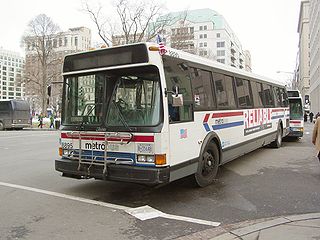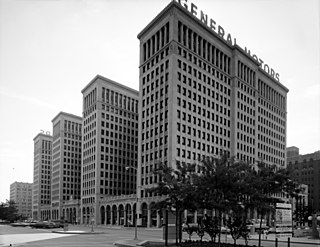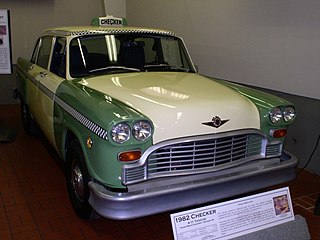
A bus is a motor vehicle that carries significantly more passengers than an average car or van, but fewer than the average rail transport. It is most commonly used in public transport, but is also in use for charter purposes, or through private ownership. Although the average bus carries between 30 and 100 passengers, some buses have a capacity of up to 300 passengers. The most common type is the single-deck rigid bus, with double-decker and articulated buses carrying larger loads, and midibuses and minibuses carrying smaller loads. Coaches are used for longer-distance services. Many types of buses, such as city transit buses and inter-city coaches, charge a fare. Other types, such as elementary or secondary school buses or shuttle buses within a post-secondary education campus, are free. In many jurisdictions, bus drivers require a special large vehicle licence above and beyond a regular driving license.

GMC is a division of American automotive manufacturer General Motors (GM) for trucks and utility vehicles. GMC currently makes SUVs, pickup trucks, vans, and light-duty trucks. In the past, GMC also produced fire trucks, ambulances, heavy-duty trucks, military vehicles, motorhomes, transit buses, and medium duty trucks.

The Flxible Co. was an American manufacturer of motorcycle sidecars, funeral cars, ambulances, intercity coaches and transit buses, based in the U.S. state of Ohio. It was founded in 1913 and closed in 1996. The company's production transitioned from highway coaches and other products to transit buses over the period 1953–1970, and during the years that followed, Flxible was one of the largest transit-bus manufacturers in North America.

The General Motors streetcar conspiracy refers to the convictions of General Motors (GM) and related companies that were involved in the monopolizing of the sale of buses and supplies to National City Lines (NCL) and subsidiaries, as well as to the allegations that the defendants conspired to own or control transit systems, in violation of Section 1 of the Sherman Antitrust Act. This suit created lingering suspicions that the defendants had in fact plotted to dismantle streetcar systems in many cities in the United States as an attempt to monopolize surface transportation.

The Chicago "L" is the rapid transit system serving the city of Chicago and some of its surrounding suburbs in the U.S. state of Illinois. Operated by the Chicago Transit Authority (CTA), it is the fourth-largest rapid transit system in the United States in terms of total route length, at 102.8 miles (165.4 km) long as of 2014, and the third-busiest rapid transit system in the United States after the New York City Subway and the Washington Metro. As of January 2024, the "L" had 1,480 rail cars operating across eight different routes on 224.1 miles of track. CTA trains make about 1,888 trips each day servicing 146 train stations. In 2023, the system had 117,447,000 rides, or about 416,200 per weekday in the third quarter of 2024.

The Chicago Transit Authority (CTA) is the operator of mass transit in Chicago, Illinois, United States, and some of its suburbs, including the trains of the Chicago "L" and CTA bus service. In 2023, the system had a ridership of 279,146,200, or about 993,700 per weekday as of the third quarter of 2024.

Yellow cab taxicab operators exist all around the world. The original Yellow Cab Company, based in Chicago, Illinois, was one of the largest taxicab companies in the United States.

The Yellow Cab Company was a taxicab company in Chicago which was co-founded as the Walden W. Shaw Livery Company in 1907 by Walden W. Shaw and John D. Hertz. The Yellow Cab Company's rapid growth in the late 1910s and 1920s innovated a new kind of taxi company, one which covered the entire city limits, promising a cab to any address in ten minutes or less. In establishing its service, the Yellow Cab Company developed many of the procedures and safety protocols that would be adopted by taxi companies around the country. The company's meteoric success also invited bitter competition on the city's streets, leading to a period known as the "Taxi Wars." During the Depression, Morris Markin, owner of Yellow Cab's rival Checker Cab Mfg. Company, significantly consolidated ownership of the city's taxi companies, putting an end to the violence. Yellow Cabs remain on the city's streets today, though ownership was split between multiple companies upon its declaration of bankruptcy in 2015.

The Yellow Cab Manufacturing Company was established in 1920 by John D. Hertz and was associated with the Yellow Cab Company which Hertz also owned.
The St. Louis Car Company was a major United States manufacturer of railroad passenger cars, streetcars, interurbans, trolleybuses and locomotives. It operated from 1887 to 1974 and was based in St. Louis, Missouri.
The Yellow Coach Manufacturing Company was an early manufacturer of passenger buses in the United States. Between 1923 and 1943, Yellow Coach built transit buses, electric-powered trolley buses, and parlor coaches.

John Daniel Hertz Sr. was an American businessman, thoroughbred racehorse owner and breeder, and philanthropist.

Kenosha Area Transit is a city-owned public transportation agency based in Kenosha, Wisconsin.

The Chicago Surface Lines (CSL) was operator of the street railway system of Chicago, Illinois, from 1913 to 1947. The firm is a predecessor of today's publicly owned operator, the Chicago Transit Authority.
The current rolling stock of the Chicago "L" rapid transit system consists of four series of railcars. The oldest series is the 2600-series which was built between 1981 and 1987 and refurbished between 1999 and 2002. The second series is the 3200-series, built between 1992 and 1994 and refurbished between 2015 and 2018. The third and newest series is known as the 5000-series; built between 2009 and 2015, they feature new technologies such as LED color signs, security cameras, new seating configuration, AC motors, and interior LED signs displaying date and time. The most recent order consists of the 7000-series cars that are planned to replace the 2600-series cars, with options for additional cars that would replace the 3200-series cars.

Oakton–Skokie is an 'L' station on the CTA's Yellow Line, which serves downtown Skokie. Previously, a station existed at this location which was in operation as part of the North Shore Line's Niles Center Route from 1925 until 1948, and later demolished in 1964. The current station opened on April 30, 2012.

Public transport bus services are generally based on regular operation of transit buses along a route calling at agreed bus stops according to a published public transport timetable.
The Omnibus Corporation is an American bus company that was formed in 1924 and acquired control of Fifth Avenue Coach Company and the Chicago Motor Coach Company with John D. Hertz as chairman. In 1953, it purchased Yellow Drive-It-Yourself from General Motors and sold its interests in public transport. The following year the company was renamed The Hertz Corporation and was floated on the New York Stock Exchange.

The New York City Omnibus Corporation ran bus services in New York City between 1926 and 1962. It expanded in 1935/36 with new bus routes to replace the New York Railways Corporation streetcars when these were dismantled. It further expanded with the acquisition of the Fifth Avenue Coach Company from The Omnibus Corporation in 1954. NYCO was renamed the "Fifth Avenue Coach Lines, Inc." in 1956, becoming bankrupt in 1962, after which operations were taken over by the Manhattan and Bronx Surface Transit Operating Authority.

Checker Taxi was a dominant taxicab company and national franchisor that was based in Chicago, Illinois. Checker Motors was an American vehicle manufacturer based in Kalamazoo, Michigan that built the iconic Checker Taxicab, sold commercially as the Checker Marathon until 1982. Both companies were owned by Morris Markin by the 1930s.
















